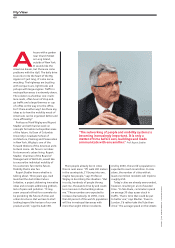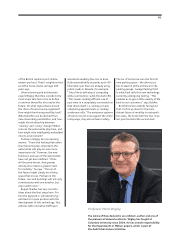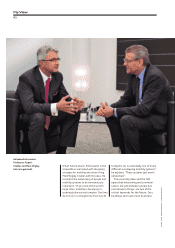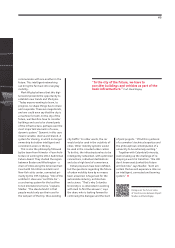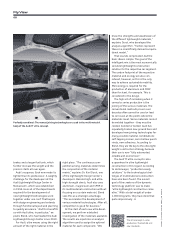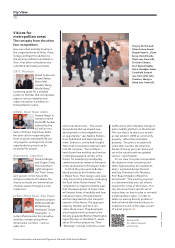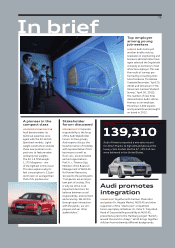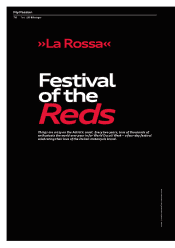Audi 2012 Annual Report Download - page 69
Download and view the complete annual report
Please find page 69 of the 2012 Audi annual report below. You can navigate through the pages in the report by either clicking on the pages listed below, or by using the keyword search tool below to find specific information within the annual report.
Lightweight construction can
be reduced to a succinct
formula: Less is more. Audi
has an excellent grasp of
this art. “Our engineers don’t
consider lightweight construction to be
a compulsory task; it is much more a
part of the Audi DNA,” explains Dr.-Ing.
Lutz-
Eike Elend, Head of the Audi Light-
weight
Design Center in Neckarsulm.
“We have a long tradition of light-
weight construction extending back to
racing in the 1930s.” The principle back
then was no dierent than it is today.
Components must be developed so
that they fulfill the required function at
the lowest possible weight.
The Audi TT ultra concept embodies
the visionary expression of this classic
Audi maxim down to the last detail. At
just 163 kilograms, its body is a prime
example of systematic lightweight
construction. An additional 43 kilograms
of weight have been trimmed compared
with the already lightweight body of
the production Audi TT.
The secret is intelligent composite
construction. The steel components
in the rear section have been largely
replaced by lighter aluminum, and
many structural components are made
of carbon-fiber-reinforced polymer
(CFRP). “With the Audi TT ultra con-
cept, we want to demonstrate what
is pos sible with the technologies of
today, tomorrow and beyond,” says
Heinz Hollerweger, Head of Total
Vehicle Development at AUDI AG.
“One goal was to drop below the
magic threshold of 1,000 kilograms
total weight.”
The engineers were therefore not
content to put just the body on a diet.
They also made changes to the chassis,
drive system, electrical system, onboard
electronics and interior equipment.
This trimmed another 260 kilograms
compared with the current production
model, or more than 20 percent of
the original weight. “The Audi TT ultra
concept represents the cutting edge of
lightweight construction,” says Peter
Fromm, Head of Body Development at
AUDI AG. “It includes technologies at
varying degrees of maturity. Some are
borrowed from the current production
series; other elements anticipate
future models.”
The technology platform also show-
cases lightweight technologies whose
use in production vehicles lies far in the
future. Instead of a heavy lead battery,
there is a modern lithium-ion battery
on board. The liners in the interior
made of premium, high-gloss, exposed
CFRP are reminiscent of Audi racing
cars. “The greatest aspiration is to take
high-end technologies that are initially
reserved for racing and refine them
to the point that they are suitable for
high-volume production,” says Elend.
The results were obvious to the
developers of the Audi TT ultra concept
during the first test drives. “The low
vehicle weight led to very good hand-
ling and outstanding performance,”
reports Hollerweger. And that with
much greater eciency, as evidenced
by the approximately 20 percent
reduction in fuel consumption and
correspondingly lower CO₂ emissions.
“Furthermore, Audi ultra can also
help to achieve improved emergency
handling and shorter stopping
distances.”
Many of the technologies showcased
in the Audi TT ultra concept will be
used in future Audi production vehicles
across the entire model lineup. But the
ultra lightweight construction strategy
is already paying dividends for today’s
customers. Depending on the version,
the Audi A6 is up to 80 kilograms
lighter than its predecessor. “What
applies to the rest of our models also
applies to the Audi A6: Every gram
counts,” says Audi developer Fromm.
“Each component is placed on the scale
and improved.” The results are lower
consumption and greater dynamics.
Previously it was almost a law of
nature in carmaking that each model
gained weight from generation to
generation – an upshot of added
comfort and safety or the integration
of alternative drive systems. And this
weight gain was not without con-
sequences. The Audi developers refer
to “secondary eects”: More weight
requires greater engine power in order
to keep performance constant. This
leads to heavier-duty gearboxes and
The ultra concept in series
production: the Audi A6
Aluminum sheet
Aluminum casting
Aluminum section
Steel, hot-shaped
Steel, cold-shaped
My View
66






